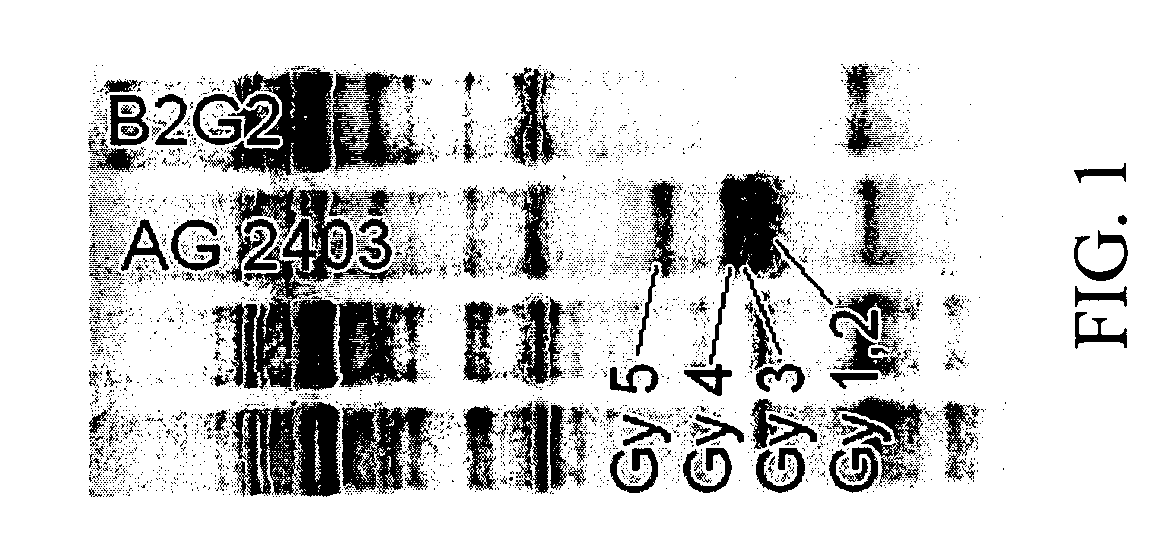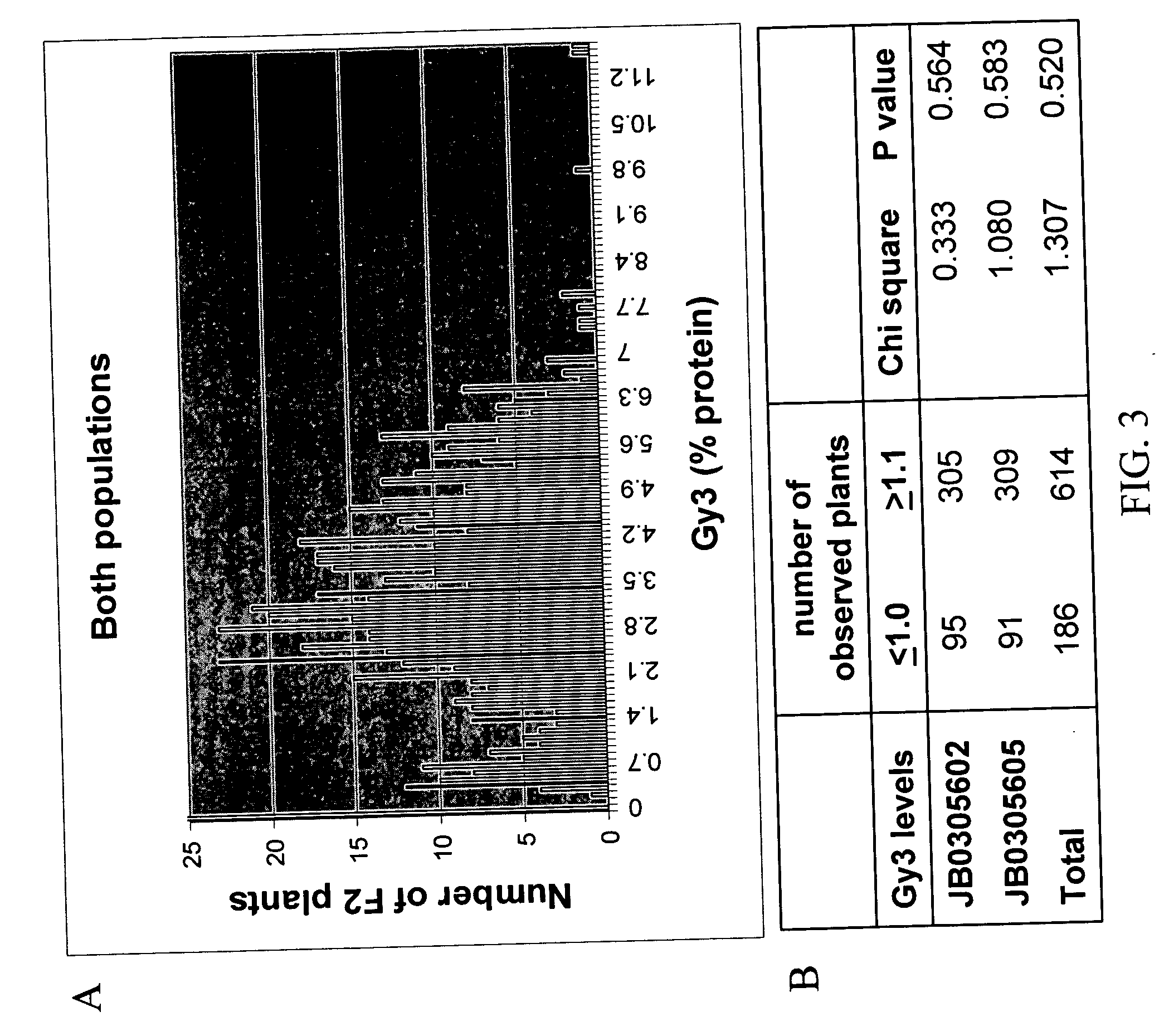Agronomically elite soybeans with high beta-conglycinin content
a technology of beta-conglycinin and soybean, which is applied in the field of plant breeding and molecular biology, can solve the problems of difficult identification of individuals that are genetically superior, labor-intensive typing stage of rflps, and difficult linkage, so as to and increase the content of seed -conglycinin
- Summary
- Abstract
- Description
- Claims
- Application Information
AI Technical Summary
Benefits of technology
Problems solved by technology
Method used
Image
Examples
example 1
Soybean Varieties Used in Studies
[0149] The B2G2 or “11S null” soybean variety has a unique seed composition including high level of β-conglycinin and low amount of glycinin. However, the B2G2 variety exhibits agronomically inferior characteristics such as low yield, excessive lodging and green seed. A number of breeding lines were developed, which carried all or parts of the mutations present in the B2G2 lines. Fifteen such lines together with B2G2 lines were used as mutant lines in resequencing panel. Eight wild types were used for comparison in this study. Table 1 lists all the lines used in the sequencing panel.
TABLE 1LineName orSymbolPedigreeJB1AH_(A3244 / (B2G2 / A1923:.077.):0001.0097.0015.) / DJW2500C0R:@.0042.0006.@.JB2AH_(A3244 / (B2G2 / A1923:.077.):0001.0064.0001.) / DKB19-51:@.0232.0002.@.JB3AH_(A3244 / (B2G2 / A1923:.077.):0001.0064.0001.) / DKB19-51:@.0228.0015.@.JB4AH_(A3244 / (B2G2 / A1923:.077.):0001.0097.0011.) / DAK2501A0R:@.0314.0009.@.JB5AH_(A3244 / (B2G2 / A1923:.077.):0001.0097.0015....
example 2
Design of Markers for Gy Alleles
[0150] DNA sequences for all the glycinin genes are available in GenBank (NCBI). These sequences were used as queries to blast against a Monsanto sequence database. Using “blastn” programs, a number of high score hits were obtained. The resulting sequences from the blast search were aligned to provide a high quality consensus sequences for use in primer design. Nested primers were designed to completely cover the entire gene at each locus and amplicons were generated from different lines. Sequences of these amplicons were aligned to identify SNPs and INDELs associated with high β-conglycinin phenotypes. Initially 10 pairs of primers were designed for Gy1, 7 pairs each for Gy2 and Gy3, 14 pairs for Gy4, 10 pairs for Gy5 and 11 pairs for Gy7. Additional primers were designed once their sequences were known from this study. Table 2 lists the primers used in the study.
[0151] DNA was isolated with Qiagen Plant DNA kits, and PCR was performed with KOD pro...
example 3
Methods for Gy Expression Analysis
[0153] Genetic conformation of the Gy markers was carried out in two F2 populations designated JB0305602 and JB0305605, which were derived from the crosses between AAH3504TOC / AH0209439-130 and AAH2104JOC / AH0209439-130, respectively. Four hundred F2 individual plants were sampled and 372 plants were genotyped with SNP markers.
[0154] Protein analysis was carried out as follows: Eight soybean seeds were pooled and ground using the CAT Mega-Grinder (SOP Asci-01-0002). Ground samples were stored at 4° C. For analysis, ˜30 mg of flour from each was weighed into one well of a 96 well 2 ml microtiter plate. Protein was extracted for 1 hour with shaking in 1.0 ml 1X Laemmli SDS buffer pH 6.8 containing 0.1M dithiothreitol (DTT) as a reductant. Following centrifugation, a portion of each extract was further diluted in SDS buffer to yield 0.2-0.5 μg / μL total protein, heated to 90-100° C. for 10 min, and cooled. For each sample, 1-2 μg total protein was loade...
PUM
| Property | Measurement | Unit |
|---|---|---|
| Fraction | aaaaa | aaaaa |
| Fraction | aaaaa | aaaaa |
| Fraction | aaaaa | aaaaa |
Abstract
Description
Claims
Application Information
 Login to View More
Login to View More - R&D
- Intellectual Property
- Life Sciences
- Materials
- Tech Scout
- Unparalleled Data Quality
- Higher Quality Content
- 60% Fewer Hallucinations
Browse by: Latest US Patents, China's latest patents, Technical Efficacy Thesaurus, Application Domain, Technology Topic, Popular Technical Reports.
© 2025 PatSnap. All rights reserved.Legal|Privacy policy|Modern Slavery Act Transparency Statement|Sitemap|About US| Contact US: help@patsnap.com



